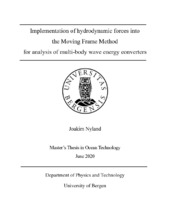Implementation of hydrodynamic forces into the Moving Frame Method for analysis of multi-body wave energy converters
Master thesis
Permanent lenke
https://hdl.handle.net/1956/22745Utgivelsesdato
2020-06-18Metadata
Vis full innførselSamlinger
- Master theses [170]
Sammendrag
The aim of this research is to implement hydrodynamic forces into the Moving Frame Method (MFM) to enable time-dependent analysis of multi-body wave energy converters in irregular sea-states. The MFM leverages Lie Group Theory, Cartan’s concept of moving frames, and Frankel’s compact notation from the discipline of geometrical physics. Furthermore, it makes use of a coherent data structure founded in the Special Euclidean Group SE(3). Together these implementations maintain a notation which is consistent from 2D to 3D single bodies to multi-bodies, allowing for analysis which can be readily scaled up to include multiple links, bodies, and farms of devices, without increasing notational complexity and without loss of generality. This work models the three-float M4 WEC subject to irregular wave spectra using the MFM and linearization by Cummins’ equation. The impulse response function is pre-computed, and the hydrodynamic coefficients are taken from a WAMIT diffraction model. The power-take-off (PTO) is modelled as a linear damper. The system of second-order ordinary differential equations is advanced in time using the fourth order Runge-Kutta numerical method. Model-scale results are compared to earlier experimental work and show close agreement, with root-mean square errors of the time-series heave and surge responses less than 4×10^(-3) m. Power capture and θ_rms show close agreement across all peak periods with only a slight underprediction (<7%) of power at peak periods shorter than 1 s. Some discrepancies between the model-scale results and earlier experimental work are found and this is attributed to moments from the WAMIT diffraction model being generated about the centre of flotation and not the centre of mass, which is required in an MFM model. Full-scale results of annual energy yield for a wave site in Ireland show only a minor underprediction (<3%) compared to an earlier vectoral mechanics model. The results validate that hydrodynamic forces have been successfully implemented into the MFM model, opening for analysis of more complex wave energy converters with higher degrees of freedom, including other multi-body marine devices.
